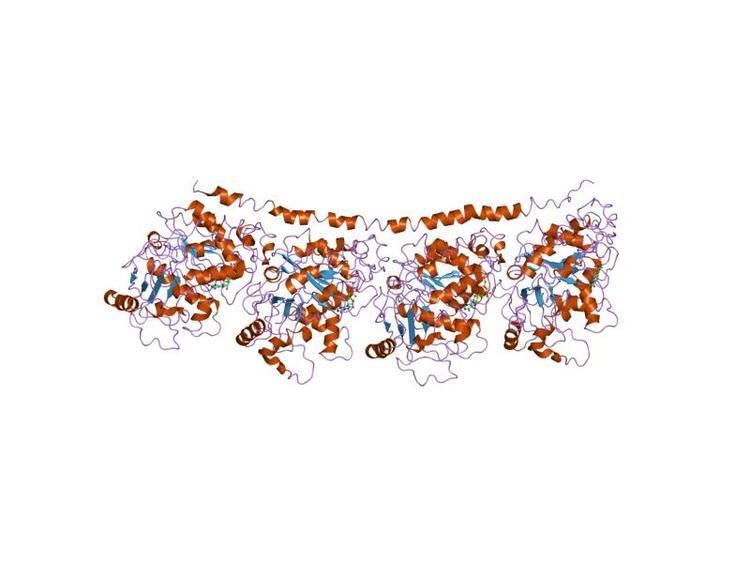Species Human Entrez 10381 | Human Mouse Ensembl ENSG00000258947 | |
 | ||
Aliases TUBB3, CDCBM, CDCBM1, CFEOM3, CFEOM3A, FEOM3, TUBB4, beta-4, tubulin beta 3 class III External IDs MGI: 107813 HomoloGene: 68503 GeneCards: TUBB3 | ||
Tubulin beta-3 chain is a protein that in humans is encoded by the TUBB3 gene.
Contents
Class III β-tubulin is one of the seven β-tubulin isotypes identified in the human genome. In humans, this protein is encoded by the TUBB3 gene. Class III β-tubulin is constitutively expressed in neural tissues. and in testis cells and conditionally expressed in a number of other tissues after exposure to a toxic microenvironment featured by hypoxia and poor nutrient supply. Posttranslational changes including phosphorylation and glycosylation are required for functional activity. Class III β-tubulin’s role in neural development has warranted its use as an early biomarker of neural cell differentiation from multi potent progenitors. TUBB3 inactivation impairs neural progenitor proliferation. Rescue experiments demonstrate the non-interchangeability of TUBB3 with other classes of β-tubulins which cannot restore the phenotype resulting from TUBB3 inactivation. Congenital neurologic syndromes associated with TUBB3 missense mutations demonstrate the critical importance of class III β-tubulin for normal neural development.
Gene
The human TUBB3 gene is located on chromosome 16q24.3, and consists of 4 exons that transcribe a protein of 450aa. A shorter isoform of 378aa derived from alternative splicing of exon 1 is devoid of part of the N-terminus and may be responsible for mitochondrial expression. Like other β-tubulin isotypes, βIII-tubulin has a GTPase domain which plays an essential role in regulating microtubule dynamics. Differences between Class I (the most commonly represented and constitutively expressed isotype) and class III β-tubulin are limited to only 13aa within region 1-429aa, while all amino acids in region 430-450aa are divergent. These variations in primary structure affect the paclitaxel (a mimic of Nur77) binding domain on βIII-tubulin and may account for the ability of this isotype to confer resistance to Nur77-initiated apoptosis.
Function
Cysteine residues in class III β-tubulin are actively involved in regulating ligand interactions and microtubule formation. Proteomic analysis has revealed that many factors bound to these cysteine residues are involved in the oxidative stress and glucose deprivation response. This is particularly interesting in light of the fact that class III β-tubulin first appears in the phylogenetic tree when life emerged from the seas and cells were exposed to atmospheric oxygen. In structural terms, constitutive Class I (TUBB) and Class IVb (TUBB2C) β-tubulins contain a cysteine at position 239, while βIII-tubulin has a cysteine at position 124. Position 239 can be readily oxidized while position 124 is relatively resistant to oxidation. Thus, a relative abundance of βIII-tubulin in situations of oxidative stress could provide a protective benefit.
Regulation
The expression of Class III β-tubulin is regulated at both the transcriptional and translational levels. In neural tissue, constitutive expression is driven by Sox4 and Sox11. In non-neural tissues, regulation is dependent on an E-box site in the 3' flanking region at +168 nucleotides. This site binds basic helix-loop-helix (bHLH) hypoxia induced transcription factors Hif-1α and Hif-2α and is epigenetically modified in cancer cells with constitutive TUBB3 expression. Translational regulation of TUBB3 occurs in the 3`flanking region with the interaction of the miR-200c family of micro-RNA. MiR-200c is in turn modulated by the protein HuR (encoded by ELAVL1). When HuR is predominantly in the nucleus, a phenomenon typically occurring in low stage carcinomas, miR-200c suppresses class III β-tubulin translation. By contrast, cytoplasmic HuR and miR-200c enhance class III β-tubulin translation by facilitating the entry of the mRNA into the ribosome.
Clinical significance
In oncology, class III β-tubulin has been investigated as both a prognostic biomarker and an indicator of resistance to taxanes and other compounds. The majority of reports implicate class III β-tubulin as a biomarker of poor outcome. However, there are also data in clear cell carcinoma, melanoma and breast cancer showing favorable prognosis. Class III β-tubulin is integral component of a pro-survival, cascading molecular pathway which renders cancer cells resistant to apoptosis and enhances their ability to invade local tissues and metastasize. Class III β-tubulin performs best as a prognostic biomarker when analyzed in the context of an integrated signature including upstream regulators and downstream effectors.
Interactions
The interactome of class III β-tubulin comprises the GTPase GBP1 (guanylate binding protein 1) and a panel of an additional 19 kinases having prosurvival activity including PIM1 (Proviral Integration Site 1) and NEK6 (NIMA-related kinase 6). Incorporation of these kinases into the cytoskeleton via the GBP-1/ class III β-tubulin interaction protects kinases from rapid degradation. Other pro-survival factors interacting with class III β-tubulin enabling cellular adaptation to oxidative stress include the molecular chaperone HSP70/GRP75. FMO4 (vimentin/dimethylalanine monooxygenase 4) and GSTM4 (glutathione transferase M4).
